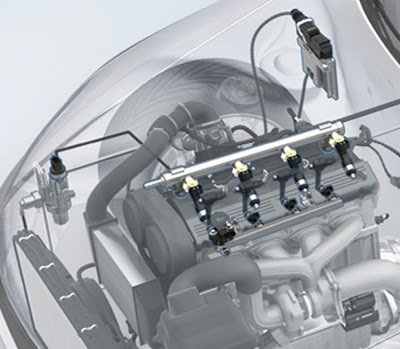Robert Bosch GmbH is a company that develops flex fuel engines. Flex fuel engines are engines that seamlessly
utilize different binary mixtures of gasoline and ethanol. In Brazil, the mixture is anywhere from E22
(22% ethanol) to E100. In the United
States, Flex Fuel engines are designed to run from E0 (no ethanol) to E85.
Bosch carries out calibrations on the engines to determine
the amount of fuel injection needed as a function of ethanol content in the
fuel (and of course, the engine being used).
This process starts in a Dyno room that spins the engine
electronically. Air is pulled from
outside the testing room and fed directly into the system. Emissions are also measured to help check the
combustion efficiency. The engine is
then mounted in a car and taken to a cold room.
The cold room includes rotating cylinders on the floor that turn the
wheels and simulate driving. Here, the
temperature can be brought down as low as -20°C. This allows the engineers to verify that the
engine will start in colder temperatures.
Afterwards, the car is brought to another room where a fan capable of
simulating 120 km/h driving speeds blows air directly into the car intake. This is the final step before taking the car
to the test track.
The purpose of all these tests is to calibrate the
engine. Adjustments need to be made in
the electrical logic systems of the engine in order to make sure fuel injection
rate is correct for the fuel mixture being used. After this programming, sensors in the
gasoline tank or in the exhaust outlet tell the computer what fuel injection
rate is appropriate. Without this step,
the engine may backfire.
This brings up an interesting economic-societal aspect of
the design process. The ethanol content
gauge in the fuel tank was deemed too expensive for the Brazilian market. An acceptable amount of these engines could
not be sold with enough overhead to Brazilian customers. Bosch’s solution was to integrate the exhaust
sensor into the computer system, allowing the program to back-calculate the
ethanol content. This calculation is
based on combustion reaction stoichiometry.
In the United States however, many customers see this method as
fallible, and prefer to pay for the fuel tank sensor.
Another interesting difference between the United States and Brazil is awareness of flex fuel engines. About 2/3 of US customers with flex fuel engines are not aware that they have the capacity to use ethanol fuels. The engineers at Bosch believe that increased awareness will lead to more pumping stations across America. This in turn will increase flex fuel vehicle sales.
One key challenge that Bosch has solved is known as “Cold
Starts”. Ethanol is more difficult to
evaporate than petroleum. This means
that at cold temperatures ethanol-petroleum mixtures would not achieve the
required vaporization with conventional fuel injection designs.
Fuel Injection Quality
Bosch’s first solution was to use pure gasoline injection on
start-up, then allow heat from the engine to fix the ethanol evaporation
problem. However, this required
customers to keep a reserve tank of pure gasoline in their vehicle. The new solution is a heating manifold that
heats the gasoline-petroleum mixture just before injection. This vaporizes enough of the ethanol to start
the car in cold climates.
Example of a Fuel Injector-Metal Bar is Heating Element
A key selling point for Bosch is that flex fuel engines give
off less greenhouse gas emissions. This
is based on the fact that the ethanol molecule has fewer carbon atoms than the
octane molecule, resulting in less carbon dioxide product. This shows how environmental factors coupled
with social awareness can be economically beneficial for a corporation.
During the presentation, a concept from my Transport Principles
class was brought up. A question was
posed as to whether or not switching from one ethanol content to another (ex.
using E22 and then E85) would shock the system.
The answer was that the computer waits for the piping to reach steady
state in the fuel lines. Also, mixing
within the fuel lines causes the effective ethanol content to change over time
rather than instantaneously. The system
only calculates the ethanol content about 3 minutes after start-up. This makes sense because ethanol content will
not change while the customer is driving, only after visiting fuel stations.
Links:



No comments:
Post a Comment